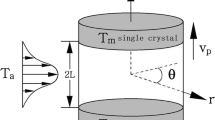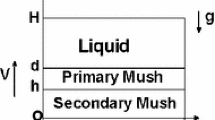Abstract
The effects of rotating magnetic field (RMF) on the three-dimensional thermocapillary flow of semiconductor melt (Pr = 0.01) in a floating half-zone model under microgravity are investigated numerically by the finite volume method. The results indicate that the thermocapillary flow without magnetic field is a steady three-dimensional convection for Ma = 40 in a floating half-zone model with As = 1, and the convection evolves to an oscillatory three-dimensional flow by applying 1–6 mT RMF with 50 Hz rotating frequency. Based on the fast Fourier transform spectrum, the convection is confirmed to be a periodically oscillating flow, the oscillatory main frequency, 1.59 × 10−3 Hz for 1 mT RMF and 5.84 × 10−2 Hz for 6 mT RMF, increases with the magnetic strength. However, with increasing the magnetic field strength up to 7 mT, the three-dimensional thermocapillary flow is effectively controlled and the convection turns into a steady axisymmetrical one.









Similar content being viewed by others
Abbreviations
- As:
-
Aspect ratio (=H/R)
- B 0 :
-
Amplitude of RMF
- \( {\mathbf{\overset{\lower0.5em\hbox{$\smash{\scriptscriptstyle\rightharpoonup}$}} {f} }}_{{\hbox {rot}}}^{*} \) :
-
Dimensionless Lorentz force
- \( f_{x}^{*} \) :
-
Dimensionless component of the Lorentz force in the x direction
- \( f_{y}^{*} \) :
-
Dimensionless component of the Lorentz force in the y direction
- \( f_{z}^{*} \) :
-
Dimensionless component of the Lorentz force in the z direction
- \(\overset{\lower0.5em\hbox{$\smash{\scriptscriptstyle\rightharpoonup}$}} {\text {F}_{{\text s}}^{*} }\) :
-
Dimensionless surface tension
- H :
-
Height of the liquid bridge
- k :
-
Thermal diffusion coefficient
- Ma:
-
Marangoni number \( \left(={\frac{{\sigma_{k} \Updelta TH}}{\rho \upsilon k}} \right) \)
- P* :
-
Dimensionless pressure
- Pr:
-
Prandtl number (=υ/k)
- R :
-
Radius of the liquid bridge
- Reω :
-
Rotation magnetic Reynolds number \( ( ={{\omega H^{2} } \mathord{\left/ {\vphantom {{\omega H^{2} } \upsilon }} \right. \kern-\nulldelimiterspace} \upsilon }) \)
- T :
-
Temperature
- T * :
-
Dimensionless temperature
- \( T_{\text{top}} \) :
-
Temperature of the top disc
- T bottom :
-
Temperature of the bottom disc
- t * :
-
Dimensionless time
- Ta:
-
Taylor number \( (=\frac{{\sigma_{e} B_{0}^{2} \omega H^{4} }}{2\upsilon \mu }) \)
- \( {\mathbf{\overset{\lower0.5em\hbox{$\smash{\scriptscriptstyle\rightharpoonup}$}} {U} }}^{*} \) :
-
Dimensionless velocity vector
- \( u^{*} \) :
-
Dimensionless velocity component in the x direction
- v * :
-
Dimensionless velocity component in the y direction
- w * :
-
Dimensionless velocity component in the z direction
- α :
-
Skin depth
- δ :
-
Kronecker operator
- λ:
-
Rotating frequency of RMF
- μ :
-
Dynamic viscosity
- υ :
-
Kinematic viscosity
- ρ:
-
Density
- σ:
-
Surface tension
- σe :
-
Electrical conductivity
- σ0 :
-
Surface tension in the reference temperature
- σ k :
-
Surface tension coefficient
- ϕ :
-
Electric potential
- ϕ * :
-
Dimensionless electric potential
- ω :
-
Rotating angular frequency
References
Levenstam M, Amberg G (1995) Hydrodynamical instabilities of thermocapillary flow in a half-zone. J Fluid Mech 297:357–372
Kuhlmann H (1999) Thermocapillary convection in models of crystal growth. Springer, Berlin
Yao L, Zeng Z, Li X, et al (2011) Effects of rotating magnetic fields on thermocapillary flow in a floating half-zone. 316:177–184
Bazzi H, Nguyen C, Galanis N (2001) Numerical study of the unstable thermocapillary flow in a silicon float zone under μ–g condition. Int J Therm Sci 40:702–716
Imaishi N, Yasuhiro S, Akiyama Y et al (2001) Numerical simulation of oscillatory Marangoni flow in half-zone liquid bridge of low Prandtl number fluid. J Cryst Growth 230:164–171
Rupp R, Müller G, Neuman G (2001) Three-dimensional time dependent modeling of the Marangoni convection in zone melting configuration for GaAs. J Cryst Growth 97:34–41
Barz RU, Gerbeth G, Wunderwald U (1997) Modelling of the isothermal melt flow due to rotating magnetic fields in crystal growth. J Cryst Growth 180:410–421
Gelfgat Y, Krūminš J, Li BQ (2000) Effects of system parameters on MHD flows in rotating magnetic fields. J Cryst Growth 210:788–796
Yildiz E, Dost S, Yildiz M (2006) A numerical simulation study for the effect of magnetic fields in liquid phase diffusion growth of SiGe single crystals. J Cryst Growth 291:497–511
Yildiz E, Dost S (2007) A numerical simulation study for the combined effect of static and rotating magnetic fields in liquid phase diffusion growth of SiGe. J Cryst Growth 303:279–283
Wang X, Ma N, Bliss DF et al (2007) Combining static and rotating magnetic fields during modified vertical Bridgman crystal growth. Reston, J Thermophys Heat Tr 21:736–743
Vizman D, Fischer B, Friedrich J et al (2000) 3D numerical simulation of melt flow in the presence of a rotating magnetic field. Int J Numer Method H 10:366–384
Barmin IV, Senchenkov AS, Greif A et al (2009) Application of rotating magnetic fields to crystal growth under microgravity (experiments on Foton-M3). Magnetohydrodynamics 45:325–331
Walker J (1998) Bridgman crystal growth with a strong, low-frequency, rotating magnetic field. J Cryst Growth 192:318–327
Dold P, Benz K (1999) Rotating magnetic fields: fluid flow and crystal growth applications. Prog Cryst Growth Ch 38:39–58
Friedrich J, Lee YS, Fischer B et al (1999) Experimental and numerical study of Rayleigh-Bénard convection affected by a rotating magnetic field. Phys Fluids 11:853–861
Gelfgat YM, Krumin J, Abricka M (1999) Rotating magnetic fields as a means to control the hydrodynamics and heat transfer in single crystal growth processes. Prog Cryst Growth Ch 38:73–132
Cröll A, Dold P, Kaiser Th, Szofran FR et al (1999) The influence of static and rotating magnetic fields on heat and mass transfer in silicon floating zones. J Electrochem Soc 146:2270–2275
Fischer B, Friedrich J, Weimann H et al (1999) The use of time-dependent magnetic fields for control of convective flows in melt growth configurations. J Cryst Growth 198(199):170–175
Senchenkov AS, Barmin IV (2003) Application of a rotating magnetic field to semiconductor crystal growth in space. Magnetohydrodynamics 39:531–538
vonAmmon W, Gelfgat Y, Gorbunov L et al (2006) Application of magnetic fields in industrial growth of silicon single crystals. Magnetohydrodynamics 42:427–444
Muižnieks A, Lācis K, Rudevičs A et al (2010) Development of numerical calculation of electromagnetic fields in FZ silicon crystal growth process. Magnetohydrodynamics 46:475–486
Dold P, Cröll A, Lichtensteiger M et al (2001) Floating zone growth of silicon in magnetic fields IV, rotating magnetic fields. J Cryst Growth 231:95–106
Martin L, Witkowski L, Walker JS (2001) Flow driven by Marangoni convection and rotating magnetic field in a floating-zone configuration. Magnetohydrodynamics 37:112–118
Walker JS, Witkowski LM, Houchens BC (2003) Effects of a rotating magnetic field on the thermocapillary instability in the floating zone process. J Cryst Growth 252:413–423
Bouizi O, Delcarte C, Kasperski G (2007) Stability study of the floating zone with respect to the Prandtl number value. Phys Fluids 19:114102
Kasperski G, Batoul A, Labrosse G (2000) Up to the unsteadiness of axisymmetric thermocapillary flows in a laterally heated liquid bridge. Phys Fluids 12:103–119
Muižnieks A, Lācis K, Nacke B (2007) 3D unsteady modelling of the melt flow in the fz silicon crystal growth process. Magnetohydrodynamics 43:377–386
Lācis K, Muižnieks A, Ratnieks G (2005) 3D mathematical model system for melt hydrodynamics in the silicon single crystal FZ-growth process with rotating magnetic field. Magnetohydrodynamics 41:147–158
Chen C, Zeng Z, Mizuseki H et al (2008) Thermocapillary convection of liquid bridge under axisymmetric magnetic fields. Mater Trans 49:2566–2571
Chen Q, Hu W (1998) Influence of liquid bridge volume on instability of floating half zone convection. Int J Heat Mass Tran 41:825–837
Zeng Z, Mizuseki H, Simamura K et al (2001) Three-dimensional oscillatory thermocapillary convection in liquid bridge under microgravity. Int J Heat Mass Tran 44:3765–3774
Nakamura S, Hibiya T, Imaishi N et al (1999) Observation of Marangoni convection in a half-zone silicon melt. Adv Space Res 24:1417–1421
Yao L, Zeng Z, Mizuseki H et al (2010) Effects of rotating magnetic fields on thermocapillary flow: comparison of the infinite and the Φ1–Φ2 models. Int J Therm Sci 49:2413–2418
Priede J (1993) Theoretical study of a flow in an axisymmetric cavity of finite length, driven by a rotating magnetic field. University of Salaspils, Latvia, PhD thesis
Yao L (2011) Convection properties in the floating half-zone and convection control of rotating magnetic fields under microgravity, Chonqing University, P. R. China, PhD thesis (in chinese)
Acknowledgments
The authors are grateful to the staff of the Center for Computer Materials Science at the Institute for Materials Research, Tohoku University, for their continuous support of the SR11000 supercomputing facilities. This work is supported by the National Natural Science Foundation of China (Grant No. 10872222 and 50921063), Research Fund for the Doctoral Program of Higher Education of China (Grant No. 20110191110037).
Author information
Authors and Affiliations
Corresponding author
Rights and permissions
About this article
Cite this article
Yao, L., Zeng, Z., Zhang, Y. et al. Influence of rotating magnetic field strength on three-dimensional thermocapillary flow in a floating half-zone model. Heat Mass Transfer 48, 2103–2111 (2012). https://doi.org/10.1007/s00231-012-1051-5
Received:
Accepted:
Published:
Issue Date:
DOI: https://doi.org/10.1007/s00231-012-1051-5




